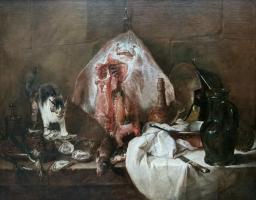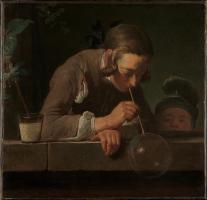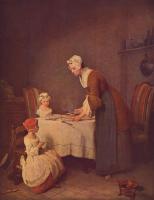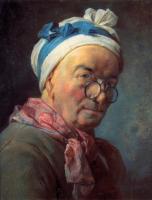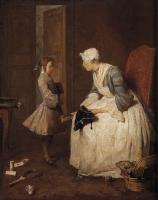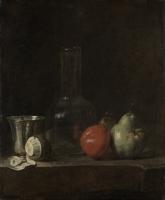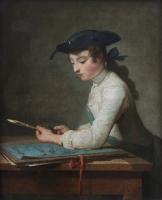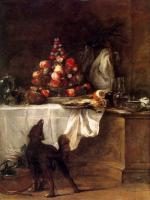Jean Siméon Chardin
Chardin, the son of a cabinet maker, lived and worked in and around Paris all his life. His father regarded painting as a craft, similar to his own, with the result that Chardin never received the full academic training required by a wide-ranging professional painter. This, combined with a lack of money, led him to opt principally for still life subjects, for which there was a ready market.
His success in his lifetime was not spectacular but steady and assured : his work was bought by distinguished international connoisseurs, he became a member of the French Royal Academy, and Louis XV not only bought some of his paintings but gave him a pension and an apartment at the Royal Palace of the Louvre.
Chardin’s pictures are thoughtful and quiet. His domestic scenes and animals, still lifes with stone jars, glass bottles, flowers, eggs and cooking pots are all painted with such feeling for texture that one could reach out and touch them.
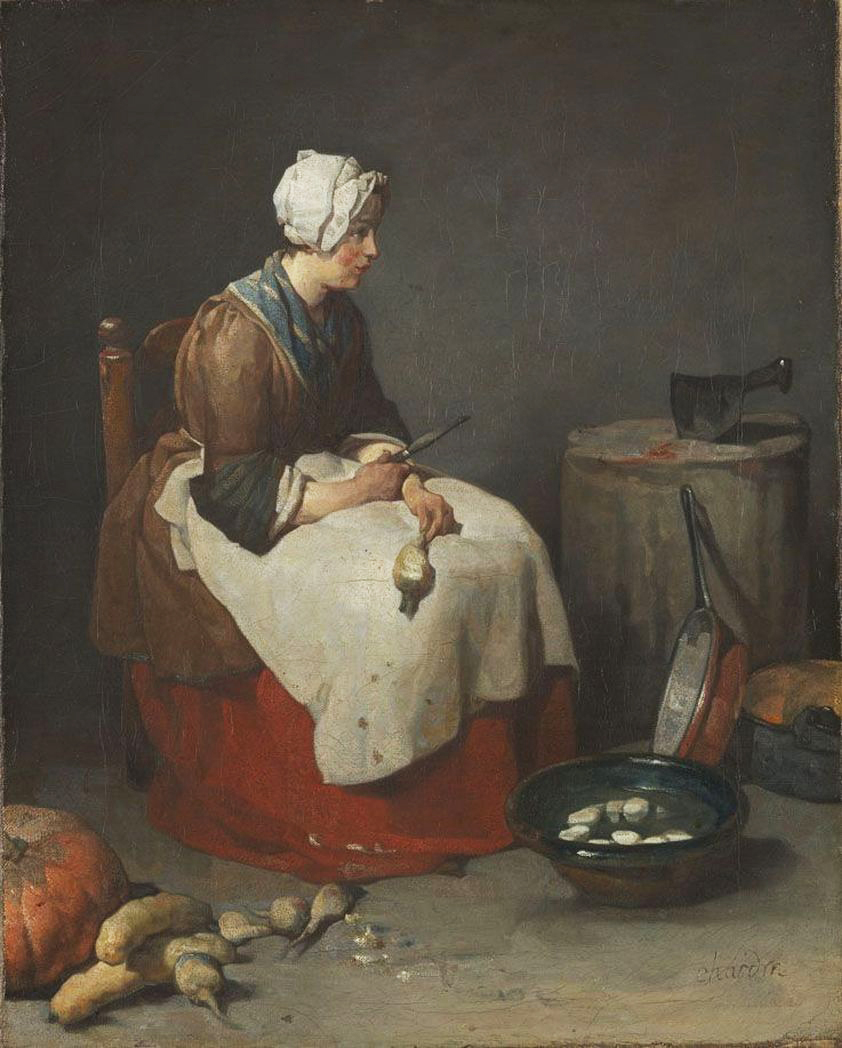 The Kitchen Maid shows a young woman pausing for a moment in her work. In
one hand she holds a kitchen knife, in the other a turnip she is peeling. She
is dressed in simple earthy colours — cream, terracotta, indigo and brown
— underlining the quiet, peaceful mood of the painting. On the floor are
more vegetables; and pots, pans, a huge chopping-block with blood stains and a
blue glazed earthenware bowl containing the already peeled vegetables surround
her.
The Kitchen Maid shows a young woman pausing for a moment in her work. In
one hand she holds a kitchen knife, in the other a turnip she is peeling. She
is dressed in simple earthy colours — cream, terracotta, indigo and brown
— underlining the quiet, peaceful mood of the painting. On the floor are
more vegetables; and pots, pans, a huge chopping-block with blood stains and a
blue glazed earthenware bowl containing the already peeled vegetables surround
her.
Every object is painted in the finest brushwork and gently pointed with delicate, gleaming touches of reflected light. The plump shapes of the vegetables are echoed by the rounded kitchen utensils and the chopping block. The human figure and the domestic objects blend together to suggest a life of simple activity in a style of painting of which Chardin was a master.
 Arguably Chardin’s most influential painting, this artwork features a gutted
rayfish, or skate. The red blood and white muscles of the ray contrast with the
fur of a cat on one side and kitchen utensils and a black pitcher on the other
side. This painting influenced the French novelist Marcel Proust, who wrote
about the artwork, as well as the painter Henri Matisse, who
reimagined it in his own version during the early twentieth century.
Arguably Chardin’s most influential painting, this artwork features a gutted
rayfish, or skate. The red blood and white muscles of the ray contrast with the
fur of a cat on one side and kitchen utensils and a black pitcher on the other
side. This painting influenced the French novelist Marcel Proust, who wrote
about the artwork, as well as the painter Henri Matisse, who
reimagined it in his own version during the early twentieth century.
This was one of a pair of paintings (The other was Le Buffett) that Chardin submitted to the French Academy when Nicholas de Largilliere first discovered him amongst other hopefuls at the Salon de Jeunesse. People had mistaken the canvases for Flemish still lifes and they were considered good enough to go forward immediately as Chardin’s diploma pieces.
 Chardin’s own son Pierre-Jean, around the age of seven. Dressed in a blue
working apron, he is pictured with a stick of white chalk in a holder,
studying a drawing in front of him. Pierre-Jean did in fact grow up to be an
artist and was living in Venice in 1767, when he died in mysterious
circumstances.
Chardin’s own son Pierre-Jean, around the age of seven. Dressed in a blue
working apron, he is pictured with a stick of white chalk in a holder,
studying a drawing in front of him. Pierre-Jean did in fact grow up to be an
artist and was living in Venice in 1767, when he died in mysterious
circumstances.


